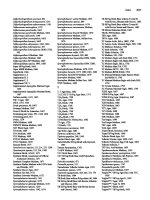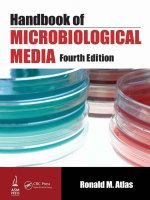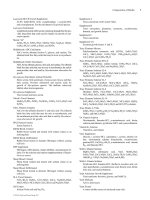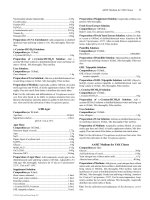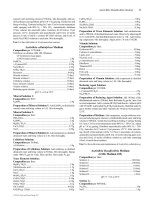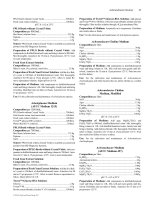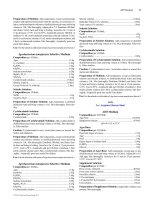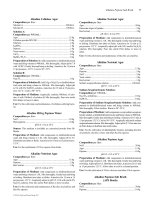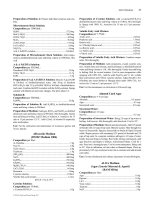Handbook of Microbiological Media, Fourth Edition part 170 pdf
Bạn đang xem bản rút gọn của tài liệu. Xem và tải ngay bản đầy đủ của tài liệu tại đây (228.91 KB, 10 trang )
TB Nitrate Reduction Broth 1685
Preparation of Bovine Albumin Solution: Add bovine albumin
to distilled/deionized water and bring volume to 100.0mL. Mix thor-
oughly. Adjust pH to 7.8 with NaOH. Store at −20°C.
Preparation of Medium: Add components, except bovine albumin
solution and glucose solution, to distilled/deionized water and bring
volume to 900.0L. Mix thoroughly. Gently heat until boiling. Auto-
clave for 15 min at 15 psi pressure–121°C. Cool to 50°C. Add 50.0mL
sterile glucose solution and 50.0mL bovine albumin solution. Mix
thoroughly. Aseptically distribute into sterile tubes.
Use: For the cultivation of Mycobacterium tuberculosis.
TB HiVeg Broth Base with Bovine Serum and Glucose
Composition per liter:
Plant peptone No. 3 4.0g
Na
2
HPO
4
2.5g
Yeast extract 2.0g
Sodium citrate 1.5g
KH
2
PO
4
1.0g
MgSO
4
0.6g
Polysorbate 80 0.5g
Glucose solution 50.0mL
Bovine serum 50.0mL
pH 7.0 ± 0.2 at 25°C
Source: This medium, without glucose or bovine albumin, is avail-
able as a premixed powder from HiMedia.
Glucose Solution:
Composition
per 100.0mL:
Glucose 10.0g
Preparation of Glucose Solution: Add glucose to distilled/deion-
ized water and bring volume to 100.0mL. Mix thoroughly. Filter ster-
ilize.
Preparation of Medium: Add components, except bovine serum
and glucose solution, to distilled/deionized water and bring volume to
900.0L. Mix thoroughly. Gently heat until boiling. Autoclave for 15
min at 15 psi pressure–121°C. Cool to 50°C. Add 50.0mL sterile glu-
cose solution and 50.0mL bovine serum. Mix thoroughly. Aseptically
distribute into sterile tubes.
Use: For the cultivation of Mycobacterium tuberculosis.
TB HiVeg Broth Base without Tween
™
80
with Bovine Albumin and Glucose
Composition per liter:
Plant peptone No. 3 4.0g
Na
2
HPO
4
2.5g
Yeast extract 2.0g
Sodium citrate 1.5g
KH
2
PO
4
1.0g
MgSO
4
0.6g
Glucose solution 50.0mL
Bovine albumin solution 50.0mL
pH 7.0 ± 0.2 at 25°C
Source: This medium, without glucose or bovine albumin, is avail-
able as a premixed powder from HiMedia.
Glucose Solution:
Composition
per 100.0mL:
Glucose 10.0g
Preparation of Glucose Solution: Add glucose to distilled/deion-
ized water and bring volume to 100.0mL. Mix thoroughly. Filter ster-
ilize.
Bovine Albumin Solution:
Composition
per 100.0mL:
Bovine albumin fraction V 10.0g
Preparation of Bovine Albumin Solution: Add bovine albumin
to distilled/deionized water and bring volume to 100.0mL. Mix thor-
oughly. Adjust pH to 7.8 with NaOH. Store at −20°C.
Preparation of Medium: Add components, except bovine albumin
solution and glucose solution, to distilled/deionized water and bring
volume to 900.0L. Mix thoroughly. Gently heat until boiling. Auto-
clave for 15 min at 15 psi pressure–121°C. Cool to 50°C. Add 50.0mL
sterile glucose solution and 50.0mL bovine albumin solution. Mix
thoroughly. Aseptically distribute into sterile tubes.
Use: For the cultivation of mycobacteria when the presence of oleic
acid is undesirable. For the cultivation of Mycobacterium tuberculosis.
TB HiVeg Broth Base without Tween
™
80
with Bovine Serum and Glucose
Composition per liter:
Plant peptone No. 3 4.0g
Na
2
HPO
4
2.5g
Yeast extract 2.0g
Sodium citrate 1.5g
KH
2
PO
4
1.0g
MgSO
4
0.6g
Glucose solution 50.0mL
Bovine serum 50.0mL
pH 7.0 ± 0.2 at 25°C
Source: This medium is available as a premixed powder from Hi-
Media.
Glucose Solution:
Composition
per 100.0mL:
Glucose 10.0g
Preparation of Glucose Solution: Add glucose to distilled/deion-
ized water and bring volume to 100.0mL. Mix thoroughly. Filter ster-
ilize.
Preparation of Medium: Add components, except bovine serum
and glucose solution, to distilled/deionized water and bring volume to
900.0L. Mix thoroughly. Gently heat until boiling. Autoclave for 15
min at 15 psi pressure–121°C. Cool to 50°C. Add 50.0mL sterile glu-
cose solution and 50.0mL bovine serum. Mix thoroughly. Aseptically
distribute into sterile tubes.
Use: For the cultivation of mycobacteria when the presence of oleic
acid is undesirable. For the cultivation of Mycobacterium tuberculosis.
TB Nitrate Reduction Broth
Composition per 100.0mL:
Na
2
HPO
4
·12H
2
O 0.485g
KH
2
PO
4
0.117g
NaNO
3
0.085g
pH 7.0 ± 0.2 at 25°C
Preparation of Medium: Add components to distilled/deionized wa-
ter and bring volume to 100.0mL. Mix thoroughly. Distribute into tubes or
flasks. Autoclave for 15 min at 15 psi pressure–121°C.
© 2010 by Taylor and Francis Group, LLC
1686 TBAB 298 Medium
Use: For the differentiation of Mycobacterium species based on nitrate
reduction. After growth of cells in appropriate medium, nitrate reduc-
tion is determined by making a suspension of cells in TB nitrate reduc-
tion broth and adding hydrochloric acid, sulfanilamide, and N-naphyl-
enendiamine. Nitrate reduction turns the medium pink. Mycobacterium
tuberculosis reduces nitrate and turns the medium deep pink within 1
min. Mycobacterium bovis does not reduce nitrate and does not change
the medium.
TBAB 298 Medium
(Tryptose 298 Blood Agar Base Medium)
Tryptose Blood Agar Base:
Composition
per 409.6mL:
Agar 15.0g
Tryptose 10.0g
NaCl 5.0g
Beef extract 3.0g
Glucose solution 4.0mL
Thymine solution 2.0mL
D-Alanine solution 2.0mL
Streptomycin sulfate solution 1.6mL
pH 7.2 ± 0.2 at 25°C
Glucose Solution:
Composition per 100.0mL:
Glucose 50.0g
Preparation of Glucose Solution: Add glucose to distilled/deion-
ized water and bring volume to 100.0mL. Mix thoroughly. Filter ster-
ilize.
Thymine Solution:
Composition
per 10.0mL:
Thymine 0.1g
Preparation of Thymine Solution: Add thymine to distilled/de-
ionized water and bring volume to 10.0mL. Mix thoroughly. Filter ster-
ilize.
D-Alanine Solution:
Composition
per 10.0mL:
D-Alanine 0.1g
Preparation of D-Alanine Solution: Add D-alanine to distilled/de-
ionized water and bring volume to 10.0mL. Mix thoroughly. Filter ster-
ilize.
Streptomycin Sulfate Solution:
Composition
per 10.0mL
Streptomycin sulfate 2.5g
Preparation of Streptomycin Sulfate Solution: Add streptomy-
cin sulfate to distilled/deionized water and bring volume to 10.0mL.
Mix thoroughly. Filter sterilize.
Preparation of Medium: Add agar, tryptose, NaCl, and beef extract
to distilled/deionized water and bring volume to 400.0mL. Mix thorough-
ly. Autoclave for 15 min at 15 psi pressure–121°C. Cool to 50°C. Asepti-
cally add 4.0mL of the sterile glucose solution, 2.0mL of the sterile
thymine solution, 2.0mL of the sterile alanine solution, and 1.6mL of the
sterile streptomycin sulfate solution. Mix thoroughly. Aseptically distrib-
ute into sterile tubes or flasks.
Use: For the cultivation of Bacillus subtilis.
TBX Agar
(Tryptone Bile X-glucuronide Agar)
Composition per liter:
Peptone 20.0g
Agar 15.0g
Bile salts 1.5g
X-β-
D-glucuronide 0.075g
pH 7.2 ± 0.2 at 25°C
Source: This medium is available from Fluka, Sigma-Aldrich.
Preparation of Medium: Add components to distilled/deionized
water and bring volume to 1.0L. Mix thoroughly. Gently heat while
stirring and bring to boiling. Autoclave for 15 min at 15 psi pressure–
121°C. Pour into sterile Petri dishes.
Use: For the detection and enumeration of E. coli in foodstuffs, animal
food, and water without further confirmation. E. coli colonies are col-
ored blue-green. The presence of the enzyme β-D-glucuronidase differ-
entiates most E. coli sp. from other coliforms. E. coli absorbs the chro-
mogenic substrate 5-bromo-4-chloro-3-indolyl-β-
D-glucuronide. The
enzyme β-glucuronidase splits the bond between the chromophore 5-
bromo-4-chloro-3-indolyl and the β-
D-glucuronide. Growth of accom-
panying Gram-positive flora is largely inhibited by the use of bile salts.
TBYA Agar
(Tryptone Beef Yeast Extract Acetate Agar)
Composition per liter:
Agar 15.0g
Pancreatic digest of casein 2.0g
Beef extract 0.5g
Yeast extract 0.5g
Sodium actuate 0.2g
pH 7.2–7.4 at 25°C
Preparation of Medium: Add components to distilled/deionized
water and bring volume to 1.0L. Mix thoroughly. Adjust pH to 7.2–7.4.
Gently heat and bring to boiling. Distribute into tubes or flasks. Auto-
clave for 15 min at 15 psi pressure–121°C. Pour into sterile Petri dishes
or leave in tubes.
Use: For the cultivation and maintenance of Leuconostoc species.
TC Amino Acids, HeLa 100X
See: Tissue Culture Amino Acids, HeLa 100X
TC Amino Acids, Minimal Eagle 50X
See: Tissue Culture Amino Acids, Minimal Eagle 50X
TC Dulbecco Solution
See: Tissue Culture Dulbecco Solution
TC Earle Solution
See: Tissue Culture Earle Solution
TC Hanks Solution
See: Tissue Culture Hanks Solution
TC Medium 199
See: Tissue Culture Medium 199
TC Medium Eagle, HeLa
See: Tissue Culture Medium Eagle, HeLa
© 2010 by Taylor and Francis Group, LLC
TCG Medium 1687
TC Medium Eagle with Earle BSS
See: Tissue Culture Medium Eagle
with Earle Balanced Salt Solution
TC Medium Eagle with Hanks BSS
See: Tissue Culture Medium Eagle
with Hank’s Balanced Salt Solution
TC Medium Ham F10
See: Tissue Culture Medium Ham F10
TC Medium NCTC 109
See: Tissue Culture Medium NCTC 109
TC Medium RPMI #1640
See: Tissue Culture Medium RPMI #1640
TC Minimal Medium Eagle Spinner Modified MEM-S
See: Tissue Culture Minimal Medium Eagle Spinner Modified
TC Minimal Medium Eagle with Earle BSS
See: Tissue Culture Minimal Medium Eagle
with Earle Balanced Salts Solution
TC Tyrode Solution
See: Tissue Culture Tyrode Solution
TC Vitamins Minimal Eagle, 100X
See: Tissue Culture Vitamins Minimal Eagle, 100X
TCBS Agar
(Thiosulfate Citrate Bile Salt Sucrose Agar)
Composition per liter:
Sucrose 20.0g
Agar 14.0g
NaCl 10.0g
Sodium citrate 10.0g
Na
2
S
2
O
3
10.0g
Yeast extract 5.0g
Pancreatic digest of casein 5.0g
Peptic digest of animal tissue 5.0g
Oxgall 5.0g
Sodium cholate 3.0g
Ferric citrate 1.0g
Thymol Blue 0.04g
Bromthymol Blue 0.04g
pH 8.6 ± 0.2 at 25°C
Source: This medium is available as a premixed powder from BD Di-
agnostic Systems.
Preparation of Medium: Add components to distilled/deionized
water and bring volume to 1.0L. Mix thoroughly. Gently heat while
stirring and bring to boiling. Do not autoclave. Cool to 45°–50°C. Pour
into sterile Petri dishes or distribute into sterile tubes.
Use: For the selective isolation of Vibrio cholerae and Vibrio para-
haemolyticus from a variety of clinical and nonclinical specimens.
TCBS HiVeg Agar
Composition per liter:
Sucrose 20.0g
Agar 15.0g
Plant peptone No. 3 15.0g
NaCl 10.0g
Sodium citrate 10.0g
Na
2
S
2
O
3
10.0g
Yeast extract 6.0g
Synthetic detergent No. II 2.0g
Ferric citrate 1.0g
Thymol Blue 0.04g
Bromthymol Blue 0.04g
pH 8.6 ± 0.2 at 25°C
Source: This medium is available as a premixed powder from Hi-
Media.
Preparation of Medium: Add components to distilled/deionized
water and bring volume to 1.0L. Mix thoroughly. Gently heat while
stirring and bring to boiling. Do not autoclave. Cool to 45°–50°C. Pour
into sterile Petri dishes or distribute into sterile tubes.
Use: For the selective isolation of Vibrio cholerae and Vibrio para-
haemolyticus from a variety of clinical and nonclinical specimens. For
the cultivation of enteropathogenic vibrios causing food poisoning.
TCBS HiVeg Agar (Selective)
Composition per liter:
Sucrose 20.0g
Agar 15.0g
Plant special peptone 14.5g
NaCl 10.0g
Sodium citrate 10.0g
Na
2
S
2
O
3
10.0g
Yeast extract 5.0g
Synthetic detergent No. II 2.0g
Synthetic detergent No. IV 1.5g
Ferric citrate 1.0g
BromthymolBlue 0.04g
Thymol Blue 0.04g
pH 8.6 ± 0.2 at 25°C
Source: This medium is available as a premixed powder from Hi-
Media.
Preparation of Medium: Add components to distilled/deionized
water and bring volume to 1.0L. Mix thoroughly. Gently heat while
stirring and bring to boiling. Do not autoclave. Cool to 45°–50°C. Pour
into sterile Petri dishes or distribute into sterile tubes.
Use: For the selective isolation of Vibrio cholerae and other entero-
pathogenic vibrios.
TCG Medium
(DSMZ Medium 1009)
Composition per liter:
Casitone 5.0g
Glucose 4.0g
Tryptone 3.0g
Artificial seawater 1.0L
pH 7.5 ± 0.2 at 25°C
Artificial Seawater:
Composition per 10.0mL:
Sea salts, Instant Ocean 22.0g
Preparation of Artificial Seawater: Add Instant Ocean sea salts
to distilled/deionized water and bring volume to 1.0L. Mix thoroughly.
© 2010 by Taylor and Francis Group, LLC
1688 TCH Medium
Preparation of Medium: Add components to artificial seawater
and bring volume to 1.0L. Mix thoroughly. Distribute to tubes or
flasks. Autoclave for 15 min at 15 psi pressure–121°C.
Use: For the cultivation of Mechercharimyces mesophilus.
TCH Medium
(Thiophene 2 Carboxylic Acid Hydrazide Medium)
Composition per 1105.0mL:
Thiophene-2-carboxylic acid hydrazide 1.1mg
Middlebrook 7H10 agar base 1.0L
OADC enrichment 100.0mL
Glycerol 5.0mL
pH 6.6 ± 0.2 at 25°C
Middlebrook 7H10 Agar Base:
Composition
per liter:
Agar 15.0g
Na
2
HPO
4
1.5g
KH
2
PO
4
1.5g
(NH
4
)
2
SO
4
0.5g
L-Glutamic acid 0.5g
Sodium citrate 0.4g
Ferric ammonium citrate 0.04g
MgSO
4
·7H
2
O 0.025g
ZnSO
4
·7H
2
O 1.0mg
CuSO
4
·5H
2
O 1.0mg
Pyridoxine 1.0mg
Biotin 0.5mg
CaCl
2
·2H
2
O 0.5mg
Malachite Green 0.25mg
Preparation of Middlebrook 7H10 Agar Base: Add glycerol to
900.0mL of distilled/deionized water and add remaining components.
Mix thoroughly. Gently heat and bring to boiling.
Middlebrook OADC Enrichment:
Composition per 100.0mL:
Bovine albumin fraction V 5.0g
Glucose 2.0g
NaCl 0.85g
Oleic acid 0.05g
Catalase 4.0mg
Source: This enrichment is available as a prepared enrichment from
BD Diagnostic Systems.
Preparation of Middlebrook OADC Enrichment: Add com-
ponents to distilled/deionized water and bring volume to 100.0mL.
Mix thoroughly. Filter sterilize.
Preparation for Medium: Combine components. Mix thoroughly.
Distribute into tubes or flasks. Autoclave for 15 min at 15 psi pressure–
121°C. Pour into sterile Petri dishes or leave in tubes.
Use: For the differentiation of Mycobacterium species based on sensi-
tivity to TCH. Mycobacterium bovis is inhibited by TCH. Mycobacte-
rium tuberculosis and other mycobacteria are generally resistant to low
concentrations of TCH. This distinguishes Mycobacterium bovis from
other nonchromogenic, slow-growing mycobacteria.
TCY Agar
Composition per liter:
NaCl 31.3g
Agar 15.0g
MgCl
2
·6H
2
O 10.8g
CaCl
2
·2H
2
O 1.0g
Casamino acids 1.0g
Tryptone 1.0g
KCl 0.7g
Yeast extract 0.2g
pH 7.2 ± 0.2 at 25°C
Preparation of Medium: Add components to distilled/deionized
water and bring volume to 1.0L. Mix thoroughly. Gently heat and bring
to boiling. Distribute into tubes or flasks. Autoclave for 15 min at 15
psi pressure–121°C. Pour into sterile Petri dishes or leave in tubes.
Use: For the cultivation and maintenance of Flexibacter maritimus.
TCY Broth
Composition per liter:
NaCl 31.3g
Agar 15.0g
MgCl
2
·6H
2
O 10.8g
CaCl
2
·2H
2
O 1.0g
Casamino acids 1.0g
Tryptone 1.0g
KCl 0.7g
Yeast extract 0.2g
pH 7.2 ± 0.2 at 25°C
Preparation of Medium: Add components to distilled/deionized
water and bring volume to 1.0L. Mix thoroughly. Distribute into tubes
or flasks. Autoclave for 15 min at 15 psi pressure–121°C.
Use: For the cultivation of Flexibacter maritimus.
TD3 Medium
(DSMZ Medium 876)
Composition per 1078.0mL:
NaCl 20.0g
MgCl
2
·6H
2
O 9.8g
Na
2
SO
4
4.0g
KCl 0.5g
NH
4
Cl 0.25g
KH
2
PO
4
0.2g
CaCl
2
·2H
2
O 0.1g
Resazurin 0.5mg
NaHCO
3
solution 50.0mL
Na
2
S·9H
2
O solution 13.0mL
Sodium caproate solution 10.0mL
Selenite-tungstate solution 2.0mL
Seven vitamin solution 1.0mL
Vitamin solution 1.0mL
Trace elements solution SL-10 1.0mL
pH 6.8 ± 0.2 at 25°C
Na
2
S·9H
2
O Solution:
Composition per 20.0mL:
Na
2
S·9H
2
O 0.6g
Preparation of Na
2
S·9H
2
O Solution: Add Na
2
S·9H
2
O to dis-
tilled/deionized water and bring volume to 20.0mL. Mix thoroughly.
Autoclave under 100% N
2
for 15 min at 15 psi pressure–121°C. Cool
to room temperature.
NaHCO
3
Solution:
Composition
per 10.0mL:
NaHCO
3
5.0g
© 2010 by Taylor and Francis Group, LLC
TDN Broth 1689
Preparation of NaHCO
3
Solution: Add NaHCO
3
to distilled/de-
ionized water and bring volume to 10.0mL. Mix thoroughly. Sparge
with 80% N
2
+ 20% CO
2
. Filter sterilize.
Sodium Caproate Solution:
Composition
per 10.0mL:
Sodium caproate 0.5g
Preparation of Sodium Caproate Solution: Add sodium cap-
roate to distilled/deionized water and bring volume to 10.0mL. Mix
thoroughly. Sparge with 100% N
2
. Filter sterilize.
Seven Vitamin Solution:
Composition
per liter:
Pyridoxine hydrochloride 300.0mg
Thiamine-HCl·2H
2
O 200.0mg
Nicotinic acid 200.0mg
Vitamin B
12
100.0mg
Calcium pantothenate 100.0mg
p-Aminobenzoic acid 80.0mg
D(+)-Biotin 20.0mg
Preparation of Seven Vitamin Solution: Add components to dis-
tilled/deionized water and bring volume to 1.0L. Sparge with 100% N
2
.
Mix thoroughly. Filter sterilize.
Vitamin Solution:
Composition
per 100.0mL:
Pyridoxine-HCl 10.0mg
Thiamine-HCl·2H
2
O 5.0mg
Riboflavin 5.0mg
Nicotinic acid 5.0mg
D-Ca-pantothenate 5.0mg
p-Aminobenzoic acid 5.0mg
Lipoic acid 5.0mg
Biotin 2.0mg
Folic acid 2.0mg
Vitamin B
12
0.1mg
Preparation of Vitamin Solution: Add components to distilled/
deionized water and bring volume to 100.0mL. Mix thoroughly. Sparge
with 80% H
2
+ 20% CO
2
. Filter sterilize.
Trace Elements Solution SL-10:
Composition
per liter:
FeCl
2
·4H
2
O 1.5g
CoCl
2
·6H
2
O 190.0mg
MnCl
2
·4H
2
O 100.0mg
ZnCl
2
70.0mg
Na
2
MoO
4
·2H
2
O 36.0mg
NiCl
2
·6H
2
O 24.0mg
H
3
BO
3
6.0mg
CuCl
2
·2H
2
O 2.0mg
HCl (25% solution) 10.0mL
Preparation of Trace Elements Solution SL-10: Add FeCl
2
·4H
2
O
to 10.0mL of HCl solution. Mix thoroughly. Add distilled/deionized
water and bring volume to 1.0L. Add remaining components. Mix thor-
oughly. Sparge with 80% N
2
+ 20% CO
2
. Autoclave for 15 min at 15
psi pressure–121°C.
Selenite-Tungstate Solution
Composition
per liter:
NaOH 0.5g
Na
2
WO
4
·2H
2
O 4.0mg
Na
2
SeO
3
·5H
2
O 3.0mg
Preparation of Selenite-Tungstate Solution: Add components
to distilled/deionized water and bring volume to 1.0L. Mix thoroughly.
Sparge with 100% N
2
. Filter sterilize.
Optional Supplemental Fatty Acid Mixture:
Composition
per 20.0mL:
Valeric acid 0.5g
Isovaleric acid 0.5g
Alpha-Methylbutyric acid 0.5g
Isobutyric acid 0.5g
Preparation of Optional Supplemental Fatty Acid Mixture:
Add components to 20.0mL distilled/deionized water. Mix thoroughly.
Sparge with 100% N
2
. Filter sterilize.
Preparation of Medium: Prepare and dispense medium under 80%
N
2
+ 20% CO
2
gas atmosphere. Add components, except NaHCO
3
solu-
tion, sodium caproate solution, Na
2
S·9H
2
O solution, vitamin solution,
seven vitamin solution, selenite-tungstate solution, and trace elements
solution SL-10, to distilled/deionized water and bring volume to 1.0L.
Mix thoroughly. Adjust pH to 7.2. Sparge with 80% N
2
+ 20% CO
2
. Au-
toclave for 15 min at 15 psi pressure–121°C. Aseptically and anaerobi-
cally add 50.0mL NaHCO
3
solution, 10.0mL sodium caproate solution,
10.0mL Na
2
S·9H
2
O solution, 1.0mL vitamin solution, 1.0mL seven vi-
tamin solution, 2.0mL selenite-tungstate solution, and 1.0mL trace ele-
ments solution SL-10. Mix thoroughly. Aseptically and anaerobically
distribute into sterile tubes or bottles. Growth can be stimulated by addi-
tion of clarified rumen fluid or 10–20mL of a mixture of fatty acids. Final
pH should be 6.7–6.9.
Use: For the cultivation of unclassified bacterium DSM 13418.
TDC Medium
Composition per liter:
Agar 20.0g
CaCO
3
10.0g
Glucose 5.0g
K
2
HPO
4
1.0g
MgSO
4
1.0g
Preparation of Medium: Add components to tap water and bring
volume to 1.0L. Mix thoroughly. Gently heat and bring to boiling. Dis-
tribute into tubes or flasks. Autoclave for 15 min at 15 psi pressure–
121°C. Pour into sterile Petri dishes or leave in tubes.
Use: For the cultivation and maintenance of Azotobacter beijerinckii
and other Azotobacter species.
TDN Broth
(DSMZ Medium 1012)
Composition per liter:
Pancreatic digest of gelatin 0.5g
Casamino acids 0.5g
Beef extract 0.3g
Yeast extract 0.1g
Magnesium chloride solution 10.0mL
Calcium chloride solution 10.0mL
pH 7.2 ± 0.2 at 25°C
Calcium Chloride Solution:
Composition
per 10.0mL:
CaCl
2
·2H
2
O 0.3g
Preparation of Calcium Chloride Solution: Add CaCl
2
·2H
2
O
to distilled/deionized water and bring volume to 10.0mL. Mix thor-
© 2010 by Taylor and Francis Group, LLC
1690 Tea Fungus Medium
oughly. Autoclave for 15 min at 15 psi pressure–121°C. Cool to room
temperature.
Magnesium Chloride Solution:
Composition
per 10.0mL:
MgCl
2
·6H
2
O 0.6g
Preparation of Magnesium Chloride Solution: Add MgCl
2
·6H
2
O
to distilled/deionized water and bring volume to 10.0mL. Mix thor-
oughly. Autoclave for 15 min at 15 psi pressure–121°C. Cool to room
temperature.
Preparation of Medium: Add components, except calcium chlo-
ride and magnesium chloride solutions, to distilled/deionized water
and bring volume to 980.0mL. Mix thoroughly. Adjust the pH to 7.2
with NaOH. Gently heat and bring to boiling. Autoclave for 15 min at
15 psi pressure–121°C. Cool to room temperature. Aspetically add cal-
cium chloride and magnesium chloride solutions. Mix thoroughly.
Use: For the cultivation of Bdellovibrio bacteriovorus.
Tea Fungus Medium
(DSMZ Medium 268)
Composition per liter:
Sucrose 50.0g
Tea leaves, black 5.0g
Add tea and sucrose to a flask. Add 1.0L freshly boiled tap water. Al-
low to stand for 15 min. Filter and cool to room temperature. Place a
small disc of a cork stopper that has been steamed for 15 min on 2 suc-
cessive days on the surface of the tea. Place the inoculum onto the cork.
Cover the beaker with aluminum foil and incubate.
Use: For the cultivation of tea fungus.
TEC Agar
(m-TEC Agar)
Composition per liter:
Agar 15.0g
Lactose 10.0g
NaCl 7.5g
Proteose peptone 5.0g
K
2
HPO
4
3.3g
Yeast extract 3.0g
KH
2
PO
4
1.0g
Sodium lauryl sulfate 0.2g
Sodium deoxycholate 0.1g
Bromcresol Purple 0.08g
Bromphenol Red 0.08g
pH 5.0 ± 0.2 at 25°C
Source: This medium is available as a premixed powder from BD Di-
agnostic Systems.
Preparation of Medium: Add components to distilled/deionized
water and bring volume to 1.0L. Mix thoroughly. Gently heat and bring
to boiling. Adjust pH to 5.0. Sterilization is unnecessary. Pour into ster-
ile Petri dishes or distribute into sterile tubes or flasks. Store at 2°–8°C.
Use within 1 week.
Use: For detection of Escherichia coli in recreational waters by the mem-
brane filter method. This agar is used in conjunction with a urea substrate
to detect urease production. After addition of the urea substrate, Escheri-
chia coli appears as yellow-yellow/brown colonies when viewed under a
fluorescent lamp.
Tech Agar
Composition per liter:
Pancreatic digest of gelatin 20.0g
Agar 13.6g
K
2
SO
4
·7H
2
O 10.0g
MgCl
2
·6H
2
O 1.4g
Glycerol 10.0mL
pH 7.2 ± 0.2 at 25°C
Source: This medium is available as a premixed powder from BD Di-
agnostic Systems.
Preparation of Medium: Add components, except glycerol, to dis-
tilled/deionized water and bring volume to 990.0mL. Mix thoroughly.
Add glycerol. Gently heat and bring to boiling. Distribute into tubes or
flasks. Autoclave for 15 min at 15 psi pressure–121°C. Pour into sterile
Petri dishes or leave in tubes.
Use: For the production of pyocyanin pigment by Pseudomonas spe-
cies.
Teepol Broth, Enriched
(m-Teepol Broth, Enriched)
Composition per liter:
Peptone 40.0g
Lactose 30.0g
Yeast extract 6.0g
Phenol Red 0.2g
Sodium lauryl sulfate
(Teepol, 0.1% solution) 4.0mL
pH 7.4 ± 0.2 at 25°C
Preparation of Medium: Add components to distilled/deionized
water and bring volume to 1.0L. Mix thoroughly. Distribute into tubes
or flasks. Autoclave for 15 min at 15 psi pressure–121°C.
Use: For the enumeration of coliform organisms and Escherichia coli in
water by the membrane filter method.
Teepol HiVeg Broth
Composition per liter:
Plant peptone 20.0g
Lactose 10.0g
NaCl 5.0g
Teepol 1.0g
Phenol Red 0.02g
pH 7.6 ± 0.2 at 25°C
Source: This medium is available as a premixed powder from Hi-
Media.
Preparation of Medium: Add components to distilled/deionized
water and bring volume to 1.0L. Mix thoroughly. Distribute into tubes
or flasks. Autoclave for 15 min at 15 psi pressure–121°C.
Use: For the enumeration of coliform organisms and Escherichia coli in
water by the membrane filter method. For the selective isolation and iden-
tification of enteric, lactose-fermenting bacteria.
Tellurite Blood Agar
See: Chocolate Tellurite Agar
Tellurite Glycine Agar
Composition per liter:
Agar 17.5g
Pancreatic digest of casein 10.0g
Glycine 10.0g
© 2010 by Taylor and Francis Group, LLC
Tepidanaerobacter Medium 1691
Yeast extract 6.5g
D-Mannitol 5.0g
K
2
HPO
4
5.0g
LiCl 5.0g
Enzymatic hydrolysate of soybean meal 3.5g
Chapman tellurite solution 10.0mL
pH 7.2 ± 0.2 at 25°C
Source: This medium is available as a premixed powder from BD Di-
agnostic Systems.
Caution: Lithium chloride is harmful. Avoid bodily contact and inha-
lation of vapors. On contact with skin wash with plenty of water imme-
diately.
Chapman Tellurite Solution:
Composition per 100.0mL:
K
2
TeO
3
1.0g
Preparation of Chapman Tellurite Solution: Add K
2
TeO
3
to
distilled/deionized water and bring volume to 100.0mL. Mix thorough-
ly. Filter sterilize.
Caution: Potassium tellurite is toxic.
Preparation of Medium: Add components, except Chapman tellu-
rite solution, to distilled/deionized water and bring volume to 990.0mL.
Mix thoroughly. Gently heat and bring to boiling. Autoclave for 15 min
at 15 psi pressure–121°C. Cool to 50°–55°C. Aseptically add 10.0mL of
sterile Chapman tellurite solution. Mix thoroughly. Pour into sterile Petri
dishes or distribute into sterile tubes. Allow the surface of the plates to
dry before inoculating.
Use: For the isolation and cultivation of coagulase-positive staphylo-
cocci.
Tellurite Glycine Agar
Composition per liter:
Agar 16.0g
Pancreatic digest of casein 10.0g
Glycine 10.0g
Yeast extract 5.0g
D-Mannitol 5.0g
K
2
HPO
4
5.0g
LiCl 5.0g
Chapman tellurite solution 20.0mL
pH 7.2 ± 0.2 at 25°C
Source: This medium is available as a premixed powder from BD Di-
agnostic Systems
.
Chapman Tellurite Solution:
Composition per 100.0mL:
K
2
TeO
3
1.0g
Preparation of Chapman Tellurite Solution: Add K
2
TeO
3
to
distilled/deionized water and bring volume to 100.0mL. Mix thorough-
ly. Filter sterilize.
Caution: Potassium tellurite is toxic.
Preparation of Medium: Add components, except Chapman tellu-
rite solution, to distilled/deionized water and bring volume to 980.0mL.
Mix thoroughly. Gently heat and bring to boiling. Autoclave for 15 min
at 15 psi pressure–121°C. Cool to 50°–55°C. Aseptically add 20.0mL of
sterile Chapman tellurite solution. Mix thoroughly. Pour into sterile Petri
dishes or distribute into sterile tubes. Allow the surface of the plates to
dry before inoculating.
Use: For the quantitative detection of coagulase-positive staphylo-
cocci from foods and other sources.
Tellurite Polymyxin Egg Yolk Agar
See: TPEY Agar
TEP Uric Acid Medium
Composition per liter:
Agar 20.0g
Na
2
HPO
4
·12H
2
O 9.0g
Uric acid 4.0g
Pancreatic digest of casein 1.7g
KH
2
PO
4
1.5g
NaCl 0.5g
Papaic digest of soybean meal 0.3g
K
2
HPO
4
0.25g
Glucose 0.25g
MgSO
4
·7H
2
O 0.2g
CaCl
2
0.02g
Ferric ammonium citrate 1.2mg
MnCl
2
·4H
2
O 1.0mg
pH 7.2 ± 0.2 at 25°C
Preparation of Medium: Add components to distilled/deionized
water and bring volume to 1.0L. Mix thoroughly. Gently heat and bring
to boiling. Distribute into tubes or flasks. Autoclave for 15 min at 15
psi pressure–121°C. Pour into sterile Petri dishes or leave in tubes.
Use: For the cultivation and maintenance of Bacillus fastidiosus and
other microorganisms that can utilize uric acid as a carbon source.
Tepidanaerobacter Medium
(DSMZ Medium 1051)
Composition per liter:
Yeast extract 2.3g
NH
4
Cl 0.54g
MgCl
2
·6H
2
O 0.2g
CaCl
2
·2H
2
O 0.15g
KH
2
PO
4
0.14g
Resazurin 0.5mg
Bicarbonate solution 10.0mL
Glucose solution 10.0mL
Sulfide solution 10.0mL
Cysteine solution 10.0mL
Trace elements solution 1.0mL
Vitamin solution 2.0mL
pH 7.1 ± 0.2 at 25°C
Trace Elements Solution:
Composition
per liter:
Nitrilotriacetic acid 12.8g
FeCl
3
·6H
2
O 1.35g
NaCl 1.0g
NiCl
2
·6H
2
O 0.12g
MnCl
2
·4H
2
O 0.1g
CaCl
2
·2H
2
O 0.1g
ZnCl
2
0.1g
Na
2
SeO
3
·5H
2
O 0.026g
CuCl
2
·2H
2
O 0.025g
CoCl
2
·6H
2
O 0.024g
Na
2
MoO
4
·2H
2
O 0.024g
H
3
BO
3
0.01g
© 2010 by Taylor and Francis Group, LLC
1692 Tepidibacter Medium
Preparation of Trace Elements Solution: Add nitrilotriacetic
acid to approximately 500.0mL of distilled/deionized water. Dissolve
by adding KOH and adjust pH to 6.5. Add remaining components.
Bring volume to 1.0L with additional distilled/deionized water. Adjust
pH to 7.0 with KOH.
Glucose Solution:
Composition per 10.0mL:
D-Glucose 2.2g
Preparation of Glucose Solution: Add glucose to distilled/deion-
ized water and bring volume to 10.0mL. Mix thoroughly. Sparge with
100% N
2
. Filter sterilize.
Sulfide Solution:
Composition per 10.0mL:
Na
2
S·9H
2
O 0.3g
Preparation of Sulfide Solution: Add Na
2
S·9H
2
O to distilled/de-
ionized water and bring volume to 10.0mL. Mix thoroughly. Autoclave
under 100% N
2
for 15 min at 15 psi pressure–121°C. Cool to room
temperature.
Bicarbonate Solution:
Composition per 10.0mL:
NaHCO
3
2.5g
Preparation of Bicarbonate Solution: Add NaHCO
3
to distilled/
deionized water and bring volume to 10.0mL. Mix thoroughly. Sparge
with a gas mixture of 80% N
2
+ 20% CO
2
. Filter sterilize.
Cysteine Solution:
Composition
per 10.0mL:
L-Cysteine-HCl·2H
2
O 0.3g
Preparation of Cysteine Solution: Add L-cysteine to distilled/de-
ionized water and bring volume to 10.0mL. Mix thoroughly. Sparge
with 100% N
2
. Filter sterilize.
Vitamin Solution:
Composition
per liter:
Pyridoxine-HCl 10.0mg
Thiamine-HCl·2H
2
O 5.0mg
Riboflavin 5.0mg
Nicotinic acid 5.0mg
D-Ca-pantothenate 5.0mg
p-Aminobenzoic acid 5.0mg
Lipoic acid 5.0mg
Biotin 2.0mg
Folic acid 2.0mg
Vitamin B
12
0.1mg
Preparation of Vitamin Solution: Add components to distilled/
deionized water and bring volume to 1.0L. Mix thoroughly. Sparge
with 100% N
2
. Filter sterilize.
Preparation of Medium: Add components, except vitamin, bicar-
bonate, glucose, cysteine, and sulfide solutions, to distilled/deionized
water and bring volume to 958.0mL. Mix thoroughly. Gently heat and
bring to boiling. Boil for 1 min. Cool to room temperature while sparg-
ing with a gas mixture of 80% N
2
+ 20% CO
2
. Dispense into culture
vessels under an atmosphere of 80% N
2
+ 20% CO
2
. Autoclave for 15
min at 15 psi pressure–121°C. Cool to room temperature. Aspetically
add vitamin, bicarbonate, glucose, cysteine, and sulfide solutions. Mix
thoroughly. Adjust the pH to 7.0–7.2.
Use: For the cultivation of Tepidanaerobacter syntrophicus.
Tepidibacter Medium
(DSMZ Medium 985)
Composition per liter:
NaCl 18.0g
Casein 10.0g
MgCl
2
·6H
2
O 4.0g
KCl 0.34g
NH
4
Cl 0.25g
Yeast extract 0.2g
KH
2
PO
4
0.18g
CaCl
2
·2H
2
O 0.11g
Fe(NH
4
)
2
(SO
4
)
2
·6H
2
O 0.02g
Resazurin 1.0mg
Bicarbonate solution 10.0mL
Vitamin solution 10.0mL
Sulfide solution 10.0mL
Trace elements solution SL-10 1.0mL
pH 6.8 ± 0.2 at 25°C
Sulfide Solution:
Composition per 10.0mL:
Na
2
S·9H
2
O 0.5g
Preparation of Sulfide Solution: Add Na
2
S·9H
2
O to distilled/de-
ionized water and bring volume to 10.0mL. Mix thoroughly. Autoclave
under 100% N
2
for 15 min at 15 psi pressure–121°C. Cool to room
temperature.
Bicarbonate Solution:
Composition per 10.0mL:
NaHCO
3
5.0g
Preparation of Bicarbonate Solution: Add NaHCO
3
to distilled/
deionized water and bring volume to 10.0mL. Mix thoroughly. Sparge
with gas mixture of 80% N
2
+ 20% CO
2
. Filter sterilize.
Vitamin Solution:
Composition
per liter:
Pyridoxine-HCl 10.0mg
Thiamine-HCl·2H
2
O 5.0mg
Riboflavin 5.0mg
Nicotinic acid 5.0mg
D-Ca-pantothenate 5.0mg
p-Aminobenzoic acid 5.0mg
Lipoic acid 5.0mg
Biotin 2.0mg
Folic acid 2.0mg
Vitamin B
12
0.1mg
Preparation of Vitamin Solution: Add components to distilled/
deionized water and bring volume to 1.0L. Mix thoroughly. Sparge
with 80% H
2
+ 20% CO
2
. Filter sterilize.
Trace Elements Solution SL-10:
Composition
per liter:
FeCl
2
·4H
2
O 1.5g
CoCl
2
·6H
2
O 190.0mg
MnCl
2
·4H
2
O 100.0mg
ZnCl
2
70.0mg
Na
2
MoO
4
·2H
2
O 36.0mg
NiCl
2
·6H
2
O 24.0mg
H
3
BO
3
6.0mg
CuCl
2
·2H
2
O 2.0mg
HCl (25% solution) 10.0mL
© 2010 by Taylor and Francis Group, LLC
Teredinobacter Medium 1693
Preparation of Trace Elements Solution SL-10: Add FeCl
2
·4H
2
O
to 10.0mL of HCl solution. Mix thoroughly. Add distilled/deionized
water and bring volume to 1.0L. Add remaining components. Mix thor-
oughly. Sparge with 100% N
2
. Autoclave for 15 min at 15 psi pressure–
121°C.
Preparation of Medium: Add components, except vitamin, bicar-
bonate, and sulfide solutions, to distilled/deionized water and bring
volume to 970.0mL. Mix thoroughly. Gently heat and bring to boiling.
Boil for 1 min. Cool to room temperature while sparging with a gas
mixture of 80% N
2
+ 20% CO
2
. Dispense into culture vessels under an
atmosphere of 80% N
2
+ 20% CO
2
. Autoclave for 15 min at 15 psi
pressure–121°C. Cool to room temperature. Aspetically add vitamin,
bicarbonate, and sulfide solutions. Mix thoroughly. Adjust the pH to
6.6–7.0.
Use: For the cultivation of Tepidibacter thalassicus and Deferribacter
autotrophicus.
Tepidibacter Medium with Peptone
(DSMZ Medium 985)
Composition per liter:
NaCl 18.0g
Peptone 10.0g
MgCl
2
·6H
2
O 4.0g
KCl 0.34g
NH
4
Cl 0.25g
Yeast extract 0.2g
KH
2
PO
4
0.18g
CaCl
2
·2H
2
O 0.11g
Fe(NH
4
)
2
(SO
4
)
2
·6H
2
O 0.02g
Resazurin 1.0mg
Bicarbonate solution 10.0mL
Vitamin solution 10.0mL
Sulfide solution 10.0mL
Trace elements solution SL-10 1.0mL
Wolfe's mineral elixir 1.0mL
pH 6.8 ± 0.2 at 25°C
Sulfide Solution:
Composition per 10.0mL:
Na
2
S·9H
2
O 0.5g
Preparation of Sulfide Solution: Add Na
2
S·9H
2
O to distilled/de-
ionized water and bring volume to 10.0mL. Mix thoroughly. Autoclave
under 100% N
2
for 15 min at 15 psi pressure–121°C. Cool to room
temperature.
Bicarbonate Solution:
Composition per 10.0mL:
NaHCO
3
5.0g
Preparation of Bicarbonate Solution: Add NaHCO
3
to distilled/
deionized water and bring volume to 10.0mL. Mix thoroughly. Sparge
with a gas mixture of 80% N
2
+ 20% CO
2
. Filter sterilize.
Vitamin Solution:
Composition
per liter:
Pyridoxine-HCl 10.0mg
Thiamine-HCl·2H
2
O 5.0mg
Riboflavin 5.0mg
Nicotinic acid 5.0mg
D-Ca-pantothenate 5.0mg
p-Aminobenzoic acid 5.0mg
Lipoic acid 5.0mg
Biotin 2.0mg
Folic acid 2.0mg
Vitamin B
12
0.1mg
Preparation of Vitamin Solution: Add components to distilled/
deionized water and bring volume to 1.0L. Mix thoroughly. Sparge
with 80% H
2
+ 20% CO
2
. Filter sterilize.
Trace Elements Solution SL-10:
Composition
per liter:
FeCl
2
·4H
2
O 1.5g
CoCl
2
·6H
2
O 190.0mg
MnCl
2
·4H
2
O 100.0mg
ZnCl
2
70.0mg
Na
2
MoO
4
·2H
2
O 36.0mg
NiCl
2
·6H
2
O 24.0mg
H
3
BO
3
6.0mg
CuCl
2
·2H
2
O 2.0mg
HCl (25% solution) 10.0mL
Preparation of Trace Elements Solution SL-10: Add FeCl
2
·4H
2
O
to 10.0mL of HCl solution. Mix thoroughly. Add distilled/deionized
water and bring volume to 1.0L. Add remaining components. Mix thor-
oughly. Sparge with 100% N
2
. Autoclave for 15 min at 15 psi pressure–
121°C.
Wolfe’s Mineral Elixir:
Composition
per liter:
MgSO
4
·7H
2
O 30.0g
NaCl 10.0g
MnSO
4
·2H
2
O 5.0g
(NH
4
)
2
NiSO
4
·6H
2
O 2.8g
CoCl
2
·6H
2
O 1.8g
ZnSO
4
·7H
2
O 1.8g
FeSO
4
·7H
2
O 1.0g
CaCl
2
·2H
2
O 1.0g
KAl(SO
4
)
2
·12H
2
O 0.18g
CuSO
4
·5H
2
O 0.1g
H
3
BO
3
0.1g
Na
2
MoO
4
·2H
2
O 0.1g
Na
2
SeO
4
0.1g
Na
2
WO
4
·2H
2
O 0.1g
Preparation of Wolfe’s Mineral Elixir: Adjust pH of 1.0L of dis-
tilled/deionized water to 1.0 with dilute H
2
SO
4
. Add remaining com-
ponents one at a time. Mix throughly to dissolve.
Preparation of Medium: Add components, except vitamin, bicar-
bonate, and sulfide solutions, to distilled/deionized water and bring
volume to 970.0mL. Mix thoroughly. Gently heat and bring to boiling.
Boil for 1 min. Cool to room temperature while sparging with a gas
mixture of 80% N
2
+ 20% CO
2
. Dispense into culture vessels under an
atmosphere of 80% N
2
+ 20% CO
2
. Autoclave for 15 min at 15 psi
pressure–121°C. Cool to room temperature. Aspetically add vitamin,
bicarbonate, and sulfide solutions. Mix thoroughly. Adjust the pH to
6.6–7.0.
Use: For the cultivation of Clostridium tepidiprofundi.
Teredinobacter Medium
Composition 1010.0mL:
Solution A 50.0mL
Solution C 750.0mL
Solution B 200.0mL
Solution D 10.0mL
© 2010 by Taylor and Francis Group, LLC
1694 Tergitol 7 Agar
Solution A:
Composition
per 50.0mL:
K
2
HPO
4
20.0mg
Na
2
CO
3
20.0mg
Ferric ammonium citrate 6.0mg
EDTA 1.0mg
Trace metal mix A5 1.0mL
Trace Metal Mix A5:
Composition
per liter:
H
3
BO
3
2.86g
MnCl
2
·4H
2
O 1.81g
ZnSO
4
·7H
2
O 0.222g
Na
2
MoO
4
·2H
2
O 0.39g
CuSO
4
·5H
2
O 0.079g
Co(NO
3
)
2
·6H
2
O 49.4mg
Preparation of Trace Metal Mix A5: Add components to dis-
tilled/deionized water and bring volume to 1.0L. Mix thoroughly.
Preparation of Solution A: Add components to distilled/deionized
water and bring volume to 50.0mL. Mix thoroughly. Autoclave for 15
min at 15 psi pressure–121°C. Cool to 50°–55°C.
Solution B:
Composition
per 200.0mL:
Agar, noble 2.0g
Preparation of Solution B: Add agar to distilled/deionized water
and bring volume to 200.0mL. Mix thoroughly. Gently heat and bring
to boiling. Autoclave for 15 min at 15 psi pressure–121°C. Cool to
50°–55°C.
Solution C:
Composition
per 750.0mL:
Seawater 750.0mL
Preparation of Solution C: Autoclave for 15 min at 15 psi pres-
sure–121°C. Cool to 50°–55°C.
Solution D:
Composition
per 10.0mL:
Cellulose, Sigmacell Type 101 1.0g
Preparation of Solution D: Add cellulose to distilled/deionized
water and bring volume to 10.0mL. Mix thoroughly. Autoclave for 15
min at 15 psi pressure–121°C. Cool to 50°–55°C.
Preparation of Medium: Aseptically combine 50.0mL of sterile
solution A, 200.0mL of sterile solution B, 750.0mL of sterile solution
C, and 10.0mL of sterile solution D. Mix thoroughly. Aseptically dis-
tribute into sterile tubes.
Use: For the cultivation of unidentified bacterium ATCC 39867.
Tergitol 7 Agar
Composition per liter:
Lactose 20.0g
Agar 13.0g
Peptone 10.0g
Yeast extract 6.0g
Meat extract 5.0g
Tergitol-7 0.1g
Bromthymol Blue 0.05g
TTC solution 5.0mL
pH 7.2 ± 0.2 at 25°C
Source: This medium is available as a premixed powder from Oxoid
Unipath.
TTC Solution:
Composition per 100.0mL:
Triphenyltetrazolium chloride 0.05g
Preparation of TTC Solution: Add triphenyltetrazolium chloride
to distilled/deionized water and bring volume to 100.0mL. Mix thor-
oughly. Filter sterilize.
Preparation of Medium: Add components to distilled/deionized
water and bring volume to 995.0mL. Mix thoroughly. Gently heat and
bring to boiling. Autoclave for 15 min at 15 psi pressure–121°C. Cool
to 50°C. Aseptically add 5.0mL of sterile TTC solution. Mix thorough-
ly. Pour into sterile Petri dishes or distribute into sterile tubes.
Use: For the detection and enumeration of coliforms. Lactose-fer-
menting bacteria appear as yellow colonies. Lactose-nonfermenting
bacteria appear as blue colonies.
Tergitol 7 Agar
Composition per liter:
Agar 15.0g
Lactose 10.0g
Yeast extract 3.0g
Pancreatic digest of casein 2.5g
Peptic digest of animal tissue 2.5g
Tergitol 7 0.1g
Bromthymol Blue 25.0mg
TTC solution 3.0mL
pH 6.9 ± 0.2 at 25°C
Source: This medium is available as a premixed powder from BD Di-
agnostic Systems.
TTC Solution:
Composition per 100.0mL:
Triphenyltetrazolium chloride 1.0g
Preparation of TTC Solution: Add triphenyltetrazolium chloride
to distilled/deionized water and bring volume to 100.0mL. Mix thor-
oughly. Filter sterilize.
Preparation of Medium: Add components to distilled/deionized
water and bring volume to 997.0mL. Mix thoroughly. Gently heat and
bring to boiling. Autoclave for 15 min at 15 psi pressure–121°C. Cool
to 50°C. Aseptically add 3.0mL of sterile TTC solution. Mix thorough-
ly. Pour into sterile Petri dishes or distribute into sterile tubes.
Use: For the selective isolation and differentiation of coliform bacteria
based on lactose fermentation. Lactose-fermenting bacteria appear as yellow
colonies. Lactose-nonfermenting bacteria appear as blue colonies.
Tergitol 7 Agar H
Composition per liter:
Agar 15.0g
Lactose 10.0g
Yeast extract 3.0g
Pancreatic digest of casein 2.5g
Peptic digest of animal tissue 2.5g
Ferric ammonium citrate 0.5g
Na
2
S
2
O
3
0.5g
Tergitol 7 0.1g
Bromthymol Blue 0.025g
pH 7.2 ± 0.2
Preparation of Medium: Add components to distilled/deionized
water and bring volume to 1.0L. Mix thoroughly. Gently heat and bring
© 2010 by Taylor and Francis Group, LLC
